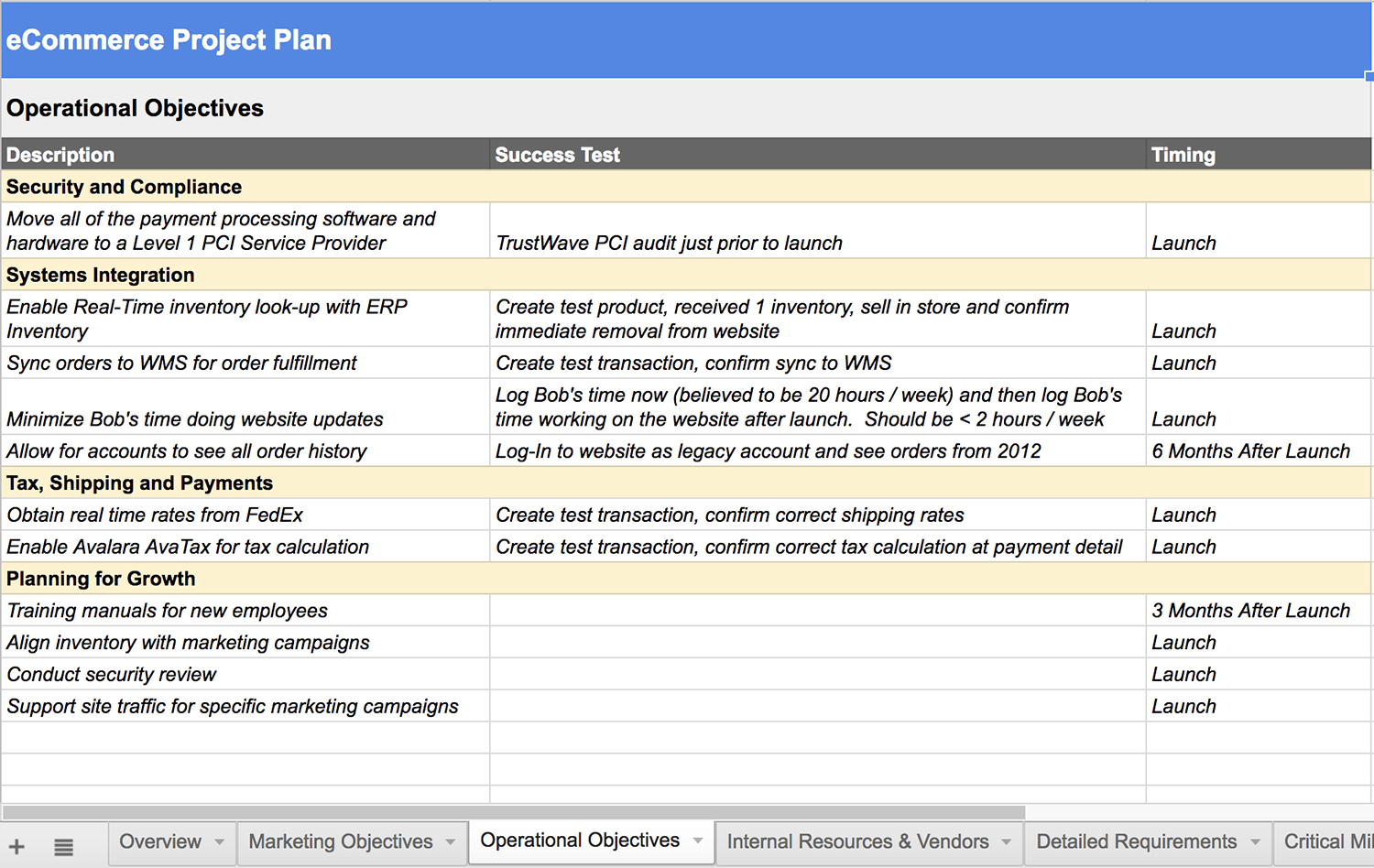EDITOR’S NOTE: This blog post is the third in a continuing series. If you’re considering an eCommerce project at your company, you’ll want to watch this space. The posts in this series – and the link to resources at the end of each post – will help you complete some vital groundwork and address important questions that will save you time, work, and money. We hope you enjoy them and find them useful.
The first and second posts of this series covered the importance of planning your eCommerce project and establishing your company’s specific marketing objectives. If you’ve already downloaded our free eCommerce Planning Template, then you’ve probably completed the first two tabs of that document, titled “Overview” and “Marketing Objectives.” (If you haven’t already read the first two blog posts in this series and populated the planning template with your own information, now is a good time to do that.)
For the purposes of this article, let’s assume you’ve completed your planning and identified your marketing objectives for your eCommerce project. Give yourself a pat on the back – you’ve got a solid foundation on which you’ll build everything else. Now it’s time to address the third tab in the eCommerce Planning Template: “Operational Objectives”. Also known as tactical objectives, these short-term goals will help bring your organization closer to its long-term goals and can also improve budgeting. When it comes to eCommerce, those objectives typically include:
- Security and compliance
- Systems integration (products, orders, and accounts)
- Tax, shipping, and payments
- Planning for growth

Let’s take a closer look at each objective and really get into the details.
First up is security and compliance. This is a big one, as you might imagine. As a matter of fact, we’re going to break it down into four smaller sub-categories.
- Payment card industry (PCI) compliance is the first. Simply put, PCI compliance requires you to follow certain security standards that protect your customers’ credit card information during and after their financial transactions. It’s important to remember that there’s no single, magic software package that will make you instantly PCI compliant. Rather, it’s your responsibility to ensure that you’re PCI compliant.
- Hosting responsibilities. You’re going to need to choose a hosting service if you want to engage in eCommerce, so be sure to put a lot of thought into that decision from a security standpoint. You might be migrating systems into or out of your direct control, so you need to think about how you are going to protect your customers’ (and your own company’s) confidential information. Ask the tough questions, and if a prospective hosting service can’t answer them to your satisfaction, then keep looking for someone who can.
- Private data storage. Geographically speaking, where do you plan to engage in eCommerce? Will you focus on domestic sales? Are you planning to branch out into different regions around the world? Wherever you do business, you’ll need to think about private data storage as well as the security of the storage method you choose. Remember that you will be governed by the laws and regulations of the regions where that private data resides.
- Accessibility and miscellaneous compliance. Have you considered that some of your prospective eCommerce customers may include people who are low-vision, hard of hearing, or otherwise disabled? You’ll want to ensure that your site is fully accessible to all users, which means you’ll need to consider how your site will accommodate aids such as screen readers and audio descriptions (for video content). Make certain that you have supporting documentation handy so that you can familiarize yourself with accessibility guidelines. You’ll avoid potential legal trouble and have the opportunity to attract business from an often overlooked customer base.
Now let’s turn to the second key operational objective – systems integration. You’ll want to address these three critical sub-areas:
- Products. Specific goals in this area can include maintaining real-time inventory, removing duplicate data-entry, and speeding up the product listing process.
- Orders. What are your operational objectives here? Some good examples would be improving your fulfillment process, resolving customer service issues, increasing visibility, eliminating duplicate data-entry from an accounting standpoint, and improving the reconciliation process.
- Accounts. Account-related tasks might include enhancing access controls and streamlining self-service account management.
The third category of operational objectives involves tax, shipping, and payments.
- As you consider taxes, you’ll want to think about how you’re going to deal with tax calculation itself. For example, you may decide to outsource those functions to a third party such as Avalara or Vertex.
- For shipping, you’ll need to determine how you are going to add and remove carriers, provide real-time quoting, and estimate delivery times.
- When it comes to payment, you’ll have to ensure alignment with other revenue channels. You’ll also have to address issues such as tokenization, subscription, security, and reconciliation.
The fourth and final operational objective in eCommerce involves planning for growth (if you haven’t already noticed, we are very big on the planning thing here at ten24). Specifically, we’re talking about these three tasks:
- Aligning with your marketing objectives. Remember the marketing objectives exercise you completed in the second blog post? Take out your marketing plan, give it a good look, and do the math – this will help you determine the transactional volumes you need.
- Addressing future security and compliance needs. As your eCommerce project progresses and grows, you may encounter new standards that you have to meet or new regulations that you need to follow. An eCommerce project is never static – it’s a constantly evolving process.
- Onboarding new employees. As your company and its eCommerce functions flourish and grow, you’ll be welcoming new employees. You can plan for that growth and have the proper training materials in place as all of those new employees come aboard.
Ready for your next homework assignment? Go to Tab 3 (titled “Operational Objectives”) in your eCommerce Planning Template. Re-read this blog post and enter all of your company’s operational objectives into Tab 3. Make sure you’ve included specific objectives for: security and compliance; systems integration; tax, shipping, and payments; and growth planning. As you did with the first two tabs of the document, be as specific as you can. Decide how you’ll measure your success in completing each task, and set timelines for all of them.
Watch for the fourth post in this series: Internal Resources and Vendors. In the meantime, please share your comments and questions about this blog post with us!


